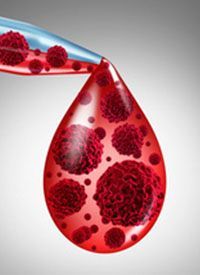Article
Real-World Data Highlight Efficacy of Ide-cel in Patients With Relapsed/Refractory Multiple Myeloma
Author(s):
A single-center study at the Dana-Farber Cancer Institute/Brigham and Women’s Hospital assessed the real-world experience of 20 patients treated with idecabtagene vicleucel with relapsed and refractory multiple myeloma who had exhausted at least 4 lines of prior therapy.

A single-center study at the Dana-Farber Cancer Institute/Brigham and Women’s Hospital assessed the real-world experience of 20 patients treated with idecabtagene vicleucel (ide-cel; Abecma) with relapsed and refractory multiple myeloma (RRMM) who had exhausted at least 4 lines of prior therapy.
Data presented at the 19th International Myeloma Society Annual Meeting reported an overall response rate (ORR) of 70%, partial response of 20%, complete response (CR) of 35% and progressive disease in 45% of patients. Very good partial responses were also reported in 15% of patients and a VGPR or greater was recorded in 50% of those treated with ide-cel. The median progression-free survival (PFS) of commercially treated patients was 23 weeks.
“This initial poster presents our data in the first 20 patients [treated] in our current study,” Dalton Canonico, MS, a graduate student in the Immune Effector Cell Therapy Program at Dana Farber Cancer Institute, explained in a presentation. “The median number of prior lines of therapy was 8, ranging from 3 to 12, so these patients were heavily pretreated.”
Ide-cel, a B-cell maturation antigen–directed CAR T-cell therapy is approved for RRMM patients who have had 4 prior lines of therapy. Ide-cel kills BCMA-expressing cells by recognizing and binding to the protein; patients T cells are then genetically modified to recognize and attack the BCMA expressing myeloma cells. Previously, the therapy demonstrated an ORR of 73% and a median PFS of 8.8 months in the KarMMA trial (NCT03361748). Because of limited commercial product availability, there is a need for data documenting real-world patient experiences, investigators wrote in a poster.
Patients underwent leukapheresis approximately 1 month prior to beginning CAR T-cell therapy and on days –5 and –3 received fludarabine/cvclophosphamid lymphodepletion therapy. Ide-cel was given on day 0. Ninety percent of patients has prior autologous stem cell transplants.
At diagnosis, the percentage of patients with RRMM had stage I, II, or III disease was 40%, 20%, and 40%, respectively. Patient age ranged from 35 to 79 years (median age 64 years), were predominately male (75%), and 90% had bridging therapy with the most common ones being DCEP and CyBorD. Patient subtypes were as follows: IgG, 55%; IgA, 20%; light chain only, 20%; and nonsecretory, 5%. Two patients in the trial with a GFR greater than 60 received a lower dose of lymphodepletion therapy and achieved a CR.
Notably, the median overall survival and median PFS has not yet been reached for patients with a CR.
“In patients with renal dysfunction, the modification to their lymphodepletion chemotherapy did not compromise response to ide-cel. Additionally, several patients treated with prior BCMA targeted therapy, responded to subsequent therapy with CAR T-cells,” Canonico said.
The most common treatment-related adverse events were anemia (80%), neutropenia (50%), and thrombocytopenia (45%); all had grade 3 levels as well of 31%, 70%, and 56%, respectively. Cytokine release syndrome (CRS) occurred in 70% of patients in grade 1 (40%) and grade 2 (30%). Tocilizumab and dexamethasone were used to combat CRS in 40% and 35% of patients, respectively. Grade 1 neurological toxicity was reported in 1 patient.
High-risk interphase fluorescence in situ hybridization was present in 45% of patients and 1q21 gain in 40%; del 17p, t(4;14), and t(14;16) were additional high-risk criteria each found in 10% of patients.
Toxicities that were nonhematological included: nausea (30%), hyponatremia (25%), constipation (25%), transaminitis (20%), insomnia (15%), hypophosphatemia (5%), and delirium (5%).
Reference
- Canonico D, Laubach J, Mo C, et al. Real world experience of patients treated with idecabtagene vicleucel: a BCMA-directed chimeric antigen receptor T-cell therapy for multiple myeloma. Poster presented at: 19th International Myeloma Society Annual Meeting; August 25-27, 2022; Los Angeles, CA.

Second-Line Ropeginterferon Alfa-2b Boosts Responses in Essential Thrombocythemia








